Barbuda

NORDLYS
David and Annette Ridout
Wed 4 Mar 2009 15:51
|
Visit to the island of
Barbuda
17:39N 61:52W
Low Bay Barbuda
2nd March 2009
Barbuda is a low sandy island lying
approximately thirty miles north of Antigua and is part of the country of
Antigua. Although over half the size of its parent island only
1600 people live there. 125 feet at its highest in an area known as 'the
highlands', it is really just a huge sand dune. For the nature lover there
are miles and miles of undeveloped beaches that team with littoral
life. Inland the huge lagoon and its mangroves provides a sanctuary for
many birds. Terns, boobies, pelicans abound but it is most famously
known for its frigate bird colony. This has been a magnet for me for many
years. Previously in 2001 we had made it to the island but were unable to
get ashore due to the huge swells that got up overnight. The history of
this island is not all sweet. The original Barbudan people were
imported as slaves by the Codrington family who leased the island from England
for one sheep per year beginning in 1685. The Codringtons then
set up a slave breeding colony and sold to Antigua their slaves and the root
crops and livestock that they grew. Sugar never featured and the home
slaves were allowed a lot of unsupervised existence. This has
resulted in a very independent, from outsiders, but dependent upon each other
life style. Land is owned communally and as there is an excess of it there
is little arguing over boundaries. Antiguans are not over
popular.
Nordlys and Oriole, a Rival Bowman 40 owned by
our friends Chris and John Lytle, enjoyed a lovely gentle sail from Falmouth
Harbour to Lower Bay on the west side of Barbuda. To call it a bay is
really a misnomer. a slight curve in the shoreline which is known here as eleven
mile beach. The approach is bounded by reefs and our arrival in the early
afternoon was perfectly timed with the sun high in the sky and behind us.
This showed that there were no 'bommies' or coral heads and we came to anchor in
5 metres on a sandy bottom. We lay about 200m off the endless
beach.
 Nordlys and Oriole at anchor off 11 mile beach Barbuda.
The colouring is not artificially enhanced!
Getting ashore was not difficult as the swell
though pronounced was not high however we took all precautions. We
used Oriole's dinghy which is much lighter than ours and has a small
outboard. Cameras etc were in waterproof cases and John timed the surf
perfectly so with one motion we landed, jumped out and carried the light
load up the beach.
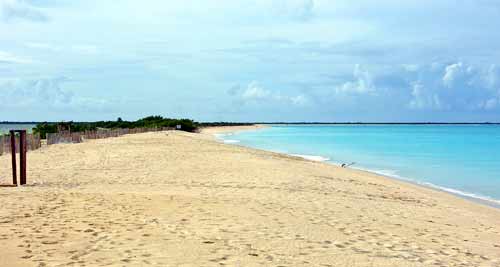 View down the beach looking south. Lagoon can just be
seen on the left and the sea on the right.
We were lucky enough to have the services of George Jeffrey as our guide. George is a local
fisherman who has lived all his life which I would guess is about 60 years, on
Barbuda. The Americans run a scheme whereby for a month at a time a
doctor comes from Virginia to the island. He or she run a surgery every
morning and for the rest of the time get to know the island and its
peoples. George has befriended many of these medics and taken them hunting
and fishing. There are wild boar on the island as well as numerous ponies
which the locals catch, train and regularly race. This interest has
resulted in George being invited often to the States. There is little he
does not know about the island and its wildlife. He also happens to be one
of life's gentle contented souls. A few hours in his company is a
tonic.
 George Jeffrey. Next day he was not available to help us
around the rest of the island
as his thumb had turned nasty. Here we are crossing the
lagoon to
Codrington. Nordlys and Oriole are at anchor the other side of the sand spit. After paying our visitor's tax of $2 per head in
the town of Codrington we headed off up to the northern end of the lagoon.
The first stop was to see an old navigation buoy that had washed up on the
eastern side of the island and had been towed into the lagoon by the locals to
salvage any worthwhile parts. One visitor went home and did research
on the internet to find the amazing fact that this buoy had come from the St
Lawrence Seaway in Canada.
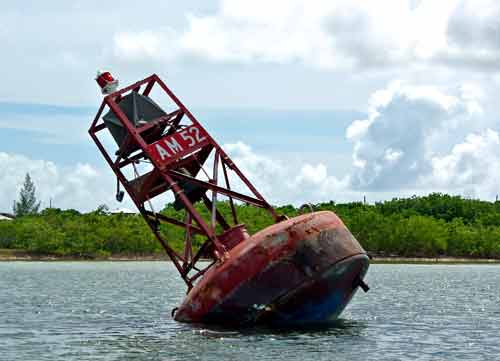 This buoy had circled the Atlantic in the currents before
ending up on Barbuda.
The dents on its side showed that several ships had hit it
during this time. One can only hope that
they were large ships and that it was not responsible for the
loss of any yachts.
Moving on up the lagoon our next stop was at a bit of regenerating mangrove, after a hurricane,
that is now the home of a colony of Pelicans. These photogenic creatures
never cease to amuse.
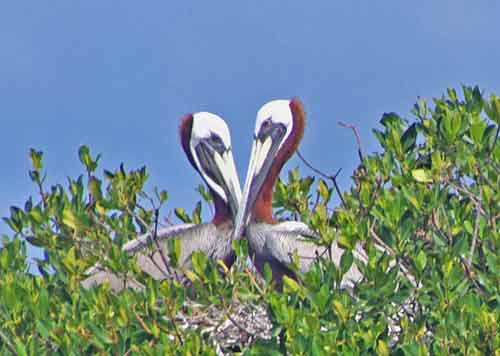 Two adult breeding brown pelicans. My bird book tells me
this as it is the only time
the birds have the pronounced brown feathers. Since
there was a chick hiding in the leaves
I can only guess that the bird book is correct.
A little bit further on the real reason for the
trip hove into sight and I must be honest also made itself known to
our olfactory nerves.
The sky was black with the birds and the mangroves
were covered with them. Adults, both female and male and many young.
We were told that this was the end of the breeding season but there were still
some males in their magnificent 'show off' state hoping for a conquest.
Most of the males were however showing signs of near exhaustion with their red
sacks either partially of fully deflated.
 The odd red sack can be seen showing out strongly even at this
range.
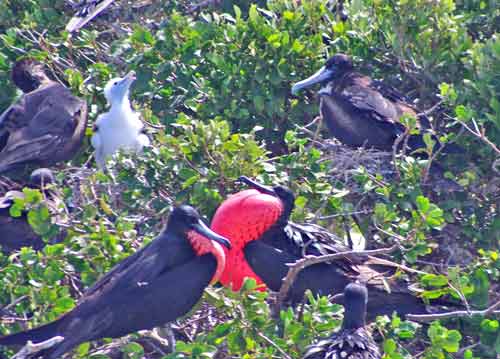 Young chick, resting mothers, a fairly tired male and one who
is still hopeful.
 While in the breeding state the males have to fly with this
extra windage. They make a fine
sight.
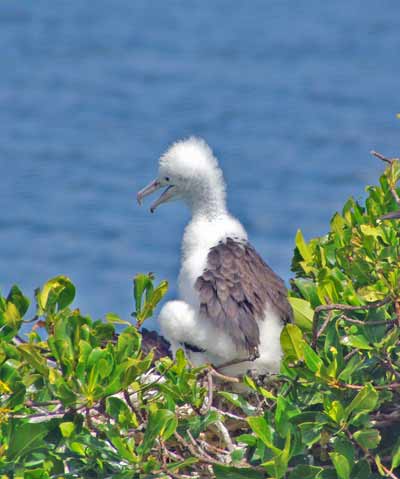 As with most creatures the chicks are very photogenic.
There are many stories about these magnificent
birds. Here are some of the facts that we are fairly sure
of and some which we are not that confident
about.
These birds can neither swim not walk. They
are diurnal, returning to roost in trees or mangroves at night. They
have a greater wing area to weight than any other bird. They either catch
their own fish by flying while scooping up the target with their large beaks or
by attacking other predators who have just caught a meal and then by
catching the resulting dropped fish or regurgitated meal while on the wing. They
are magnificent flyers and to watch them in action is always a pleasure. The
above is undoubtedly true. The next few facts are often stated but have
not been proved. There is a surprisingly large amount of ignorance over
the habits of this bird.
George told us he has seen two adults go
immediately to the rescue of another adult who had landed by mistake in the
sea. They pulled its wings with their beaks until the sufferer was
clear of the water and could fly. We have been told two reasons why
they cannot get airborne if they land by error in water. One is that their
feathers are not oily and soon become waterlogged. The other is that their
legs are so weak that they cannot flap and swim themselves airborne.
If any reader knows the answer please let us know.
After three nights anchored off this island of sand
and birds and we set sail back to Antigua. The hope was to round the south
western end of Barbuda and clear the eastern, windward end of Antigua.
This was not to be. The trades were back with a vengeance and the south
easterly course would have been only just, if at all possible, close
hauled. With large unsettled seas and twenty to twenty five knots of
true wind blowing we bore away a few degrees and with one reef and some rolls in
the genoa we set off at a steady eight knots towards the western end of
Antigua. We should have had two reefs. It was a wet bumpy ride
with salt water everywhere including some down below as our supposedly water
tight solar vent allowed gallons of water in when it was completely
submerged. Some thing it has not been until now. As I write
this Annette is doing battle with canvas, thread and the sewing machine in
order to construct a cap for it.
We let the anchor drop in four metres in Deep Bay
on the north western end of Antigua. This bay and its 'Royal Antiguan'
hotel had been my temporary home for many visits as the crews of British Airways
used to stay here. I walked up to the resort yesterday to find it well
decorated and if anything in a finer state than when I used to stay there.
What was missing were people. There was no bustle, the coffee shop was
shut and the receptionist told me that BA had not used the place for at least
five years, her time there. I would also guess that not many others are
using it either. The world seems to be very full of underutilised
resorts. Perhaps they should change their price structure.
We will spend today here, take a walk to the fort
on the hill, snorkel the wreck in the bay and then tomorrow go round to Jolly
harbour and get ready for the arrival of our next visitors, my sister Ann and
her husband Richard. Unless I can manage to get a wifi connection here I
will send this from Jolly Harbour as so many photos even in web form build up
the kilobytes well beyond iridium sending.
Happy times
David and Annette
|